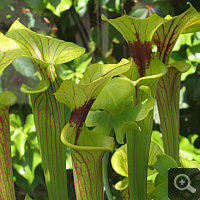North American Pitcher Plant (Sarracenia)
Overview
This genus of the North American Pitcher Plant family consists of 8 species in all (Sarracenia alata, Sarracenia flava, Sarracenia leucophylla, Sarracenia minor, Sarracenia oreophila, Sarracenia psittacina, Sarracenia purpurea and Sarracenia rubra), which all are to be found along the Atlantic coast of the USA. Only Sarracenia purpurea is to be found also deep in Canada. In addition to the 8 species exist furthermore numerous subspecies and varieties and also some natural hybrids.
Of in all 8 species produce only Sarracenia psittacina and Sarracenia purpurea the ground adjoining pitchers, by contrast the remaining 6 species have upright pitchers. Those height is between 30 cm at Sarracenia rubra and up to 120 cm at Sarracenia flava. In spring the plants start with pitcher production simultaneously with the blossom, in autumn some species change to the production of phyllodia, which are non-carnivorous leaves and look a little bit like compressed pitchers. Other species, like Sarracenia psittacina or Sarracenia purpurea, produce none of these phyllodia in autumn. They stop easily pitcher production instead.
Trap mechanism
The trap mechanism was already detailed described on the previous site. Except Sarracenia psittacina perform all North American Pitcher Plants as pure pitfall traps. In the case of direct sunlight the pitchers partially change colour intensively, in addition nectar is produced at the pitcher entry and also in the region of the lid. Both attract insects. Partly Sarracenias have also transparent windows (especially Sarracenia leucophylla, Sarracenia minor and Sarracenia psittacina), which pretend an escape route. Inside of the pitcher is a crumbly, smooth wax film to be found, so that insects fall downward. The otherwise often to seeing downward pointing hairs in pitfall traps are at least not to be found in species with erect pitchers. Sarracenia psittacina shows another trap mechanism. It grows in partially flooded regions. Inside are numerous to central pointing hairs. With the pitchers are on the one hand crawling insects, but also aquatic insects during a inundation captured. The trap operates thereby as a bow net.
Culture and Propagation
Sarracenias are easily to caring outdoor carnivorous plants. A place indoors leads in the long run to unattractive and ailing specimens. The ideal location is sunny planted out outdoors, but also a culture in the pot in ebb and flow system is possible. In this case the plant should stand from spring to the first frosts outdoors. Wintered is then within a greenhouse or at a light and cool place indoors. Plants in a pot are seriously threatened by frost because the root ball can freeze completely for weeks. Therefore potted plants have a distinct lower frost tolerance than planted out specimens. In spring old pitchers and phyllodia should be pruned, apart from that are no specific measures of care.
Sarracenia psittacina and Sarracenia oreophila deviate something from the above principle. Sarracenia psittacina is only rated as limited hardy and should at least be covered with a foliage coating in winter in the case of a place outdoors all-the-year. At the natural habitat of Sarracenia oreophila obtains a drought in summer, so that this undergoes a period of rest during this time.
The propagation of Sarracenias is easy and succeeds both generative and vegetative. The seeds should be stratified. Then sowing as light-dependent germinators. However, it takes a relative long time period until a large plant is grown up from the seedling. Significant faster is a propagation by division. In this case the same rules apply as already described for the Albany Pitcher Plant. Whereas a propagation by cuttings is not possible.

